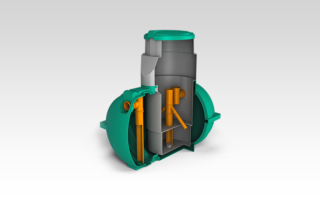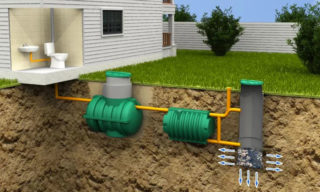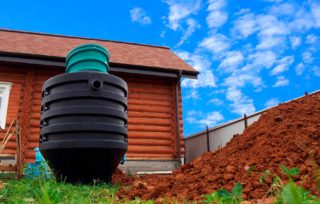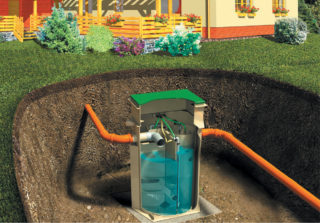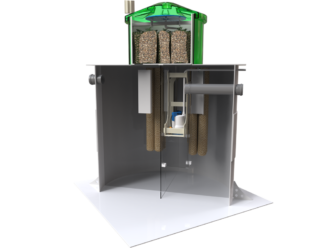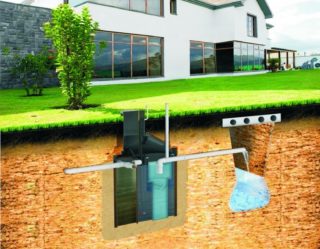For their convenience and comfort, people living permanently in a private house equip summer cottages, country villas and cottages with all kinds of sewer devices. It can be an ordinary septic tank or an autonomous sewage station. For example, if it is a large family, then of course it is better to use the station. In the event that this is a dacha where guests appear from time to time, a septic tank would be a good option, it is able to cope well with small volumes of wastewater, but it requires additional maintenance. There are no problems and its installation will cost much less than the station. What is better, it is impossible to define and precisely answer, everyone decides for himself, according to his capabilities and needs.
It is necessary to think over and install a system for cleaning and disposal of household waste at the initial stage of building a house.
Let's take a look at which of the two is better to use.
- The principle of operation of a septic tank
- How a septic tank works
- Septic tank with anaerobic bacteria
- Advantages and disadvantages of a septic tank
- The principle of operation of stationary, autonomous sewerage
- Autonomous sewerage, design features
- Advantages and disadvantages of an autonomous sewage system
- What is better to choose
The principle of operation of a septic tank
- reception of discharged waste;
- settling process;
- filtration by gravitational force;
- output of purified water to the outside.
How a septic tank works
The device is divided into several compartments, in the form of waterproof chambers. When wastewater enters the first compartment of the septic tank, the hard particles of waste that are in them settle at the bottom, sediment. This is due to the fact that in terms of their density they exceed the density of water. Having got rid of unnecessary garbage, the drains are clarified and, by overflow, they fall into the next compartment. Better cleaning follows, with the help of accumulating, replaceable filters. They remove the smallest waste from the liquid. Finally, the water is purified when it is removed from the septic tank and falling into the ground, or a special well for sludge. Drinking such water is not recommended, it is considered technical. It can be used to wash your car or use it to water your garden.
It's important to know! When installing a septic tank, no matter which company, the volume of its reservoir must be calculated based on the number of people living in the house who use drinking water. According to the statistics, on average per day, a normal person consumes up to 200, 250 liters of water. Accordingly, if a family consists of four people, then the required volume of the receiving tank of the device must be at least 800 liters.
Septic tank with anaerobic bacteria
Regardless of the septic tank device, the number of its filters and the principle of operation, the final filtration of wastewater discharged to the outside is carried out in the filtration field. This is a small piece of land on which a cushion of sand and gravel has been constructed. Liquid gets onto it from the drainage of the sewer and the soil is absorbed in a filterable way.
Attention! The distance between the drainage outlet on the filtration field and the water level is not less than 1 meter. Otherwise, it is necessary to build a well for sludge, or an earth-sand embankment.
Advantages and disadvantages of a septic tank
As everyone knows well, any unit has positive and negative characteristics of its work. The advantages of a septic tank are the following:
- Relatively low cost when compared with units and cleaning stations.
- If desired, it is possible to design it personally, the main thing is to make a volumetric tank. For this, you can use concrete rings, plastic barrels, and even car tires.
- No need to connect to power supply.
- Simplicity and low cost of maintenance.
- It is necessary to allocate a decent area of land for the installation of the tank. The tank for waste waste has large dimensions, while the level of the cleaning filters wants to be the best. In addition to all this, it is necessary to build additional treatment facilities, in the form of fields for filtration or a settling well.
- According to the recommendation of experts, the drainage container should be placed no closer than 5 meters from the residential building, but at the same time, not very far from it. Water runoff is carried out by gravity. When installing long pipes, they will quickly clog up. In the case when the structure cannot be equipped with direct drains, it becomes necessary to additionally place revision wells.
- During the construction of filtration fields, their removal to the source of drinking water should be at least 20, 50 meters. It all depends on how permeable the soil is.
- It is not recommended to set up a vegetable garden with vegetables, herbs or fruits on the ground that covers the clearing fields.
- Approximately once every 4, 6 years, there is a sharp need for periodic flushing of the drainage, drainage system and their replacement, depending on the integrity and clogging.
- As the reservoir is filled with silt, the task is to pump it out.
Of course, many users of a septic tank use it only in the spring-autumn season, the system is preserved for the winter. Unfortunately, for this it is necessary to pump out all waste from the tank by any means. Otherwise, they can silt it up.
The principle of operation of stationary, autonomous sewerage
Autonomy is a tank in which a full cycle of purification of drained water with household waste takes place. In the process of cleaning work, all decomposition actions take place inside the system. Therefore, pollution does not enter the soil or groundwater. The outlet water is clean and can be used to irrigate crops.
Autonomous sewerage, design features
The next step is fluid overflow into the adjacent compartment. It is home to and multiplies bacteria capable of decomposing waste waste into simple components, water, gas and mineral sediments. Due to the passage and cleaning with anaerobic filters, a small amount of water, in which microorganisms remain, flows back into the first compartment to treat the particles settled by sludge. At the same time, the already processed, oxygenated and pure water is discharged outside.
Advantages and disadvantages of an autonomous sewage system
- The station is able to cope with a decent volume of wastewater, thanks to the built-in pump, which speeds up filtration.
- As well as a septic tank, each station is designed for a certain number of residents using water.
- The biological treatment system is compact enough, and there is no need to allocate a large area of land for it.
- Fast installation.
- There is no need to preserve or insulate for the winter.
- It does not need to be serviced or to resort to the services of a sewer.
Of course, there are some minor flaws. Disadvantages of the biostation:
- Requires connection to power supply, pumps do not work without it. Wastewater will only be treated mechanically.
- The stations are used in homes where people live and use water. The biological bacteria living in it cannot develop without wastewater, they are their food. Their number will decrease, they will perish.
- Microorganisms inherent in the station do not tolerate all kinds of cleaning agents and chemicals very well. Bleach kills them. Accordingly, when cleaning plumbing devices, it will be necessary to exercise control over detergents.
- To prevent the filter from clogging with hair, it is necessary to install nets on the sinks and shower drains.
- The design is not cheap.
What is better to choose
How long the system can serve:
- autonomous biological station, works up to 50 years;
- a septic tank serves up to 20 years.
Recycling:
- an autonomous biological station is initially calculated for a certain amount of wastewater; there is no need for additional fields for cleaning. The technical specifications describe how much it is designed for. For example, for a family of three, a station is sufficient, which can process up to 0.8-1.0 cubic meters of liquid;
- in order for the septic tank to process exactly the same volume, it is necessary to buy an additional evacuation pump. These are costs, which, according to the installation results, are equivalent to the cost of the station.
Unpleasant scent:
- none of the septic tanks is sealed, respectively, hydrogen sulfide is released and gives out the installation site;
- the autonomous station does not have this drawback.
Water purification quality:
- any septic tank, even with the latest and most modern filters, can purify water by 75%;
- the biological station cleans by 98%, and in the case when a filter is included in the UW package, the cleaning is carried out by 100%.
System operation:
- the septic tank works without electricity, seasonally;
- autonomy, even without electricity, is able to work like a normal septic tank.
Service:
- the septic tank must be periodically cleaned and sludge pumped out, the use of additional, complex equipment;
- only flush the station and clean out the sediment.
Location:
- the septic tank is installed in places with certain angles of inclination of wastewater, take into account the remoteness to the house;
- an autonomous station is installed anywhere, even in problem soil.
In the event that this is a residential building, more than 3 people live in it all year round, the consumed volume of water is decent, then it is necessary to install an automatic wastewater treatment plant. If this is a country house, the tenants are from time to time, the site is spacious, and the soil is permeable, then in this case we choose a septic tank. In any case, it is better to contact a professional who will help you make the final decision.

